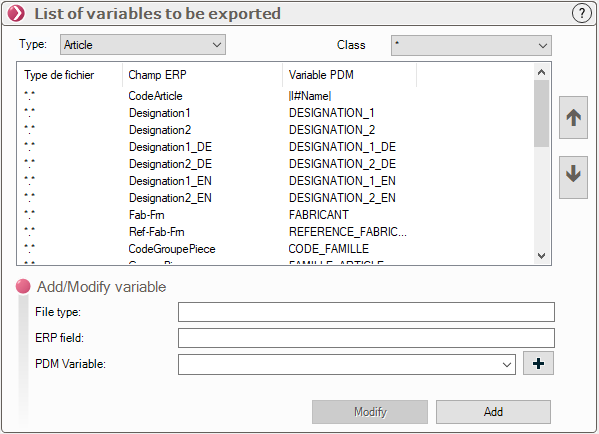Variable Matching
This form is used to define the PDM variables to be exported.

It is possible to define the PDM variables according to the type of information to be exported :
- Article: Allows you to define the PDM variables to be exported for each article.
By default, variables are defined for all material classes.
It is also possible to specify the variables to be exported for a material class by selecting it from the list Material class.
To define a new material class, go to the screen for defining material classes.
- BOM Head: Allows you to define the PDM variables to be exported for each BOM head.
It is also possible to specify the variables to be exported for a material class by selecting it from the list Material class.
- BOM Components: Allows you to define the PDM variables to be exported for each BOM component.
It is also possible to specify the variables to be exported for a material class by selecting it from the list Material class.
- Welded parts list : Allows you to define the SW properties to be exported for welded element
- PDF : Allows you to define the PDM variables to be exported for each drawing in PDF format.
For each type of information (excluding welded parts), the following fields must be filled in:
- Type of file: Allows to filter according to the type of file (part or assembly for example) the variables to be exported. *.* allows to take into account all types of documents.
- ERP field: Name of the variable in the corresponding ERP
- PDM variable: the drop-down menu contains all the variables defined in PDM.
PDM Gateway variables are also available:
- |I#Level|: retrieves the component level from the assembly BOM
- |H#Variable name of head assembly|: retrieves the variable value of the corresponding head assembly from the BOM file.
- |I#pdmweid|: allows you to retrieve the file ID in PDM
- |I#State| : allows you to retrieve the state of the document
- |I#Version : allows to retrieve the version of the document
- |I#RevisionState: retrieves the revision of the document that is included in the revision.
- RefCount : allows you to retrieve the quantity
- |D#<Name of the folder variable>| :allows you to retrieve variables from the folder card, where the document is stored
- |Thong<Text.| : allows to fill in the text defined after # ( in this case <text)
- By adding the prefix S#, followed by the Gateway parameters extracts the sub-string relating to the content of the variable value, here are some examples:
- |S#0:3 :Numart| extracts the first three characters of the Numart variable.
- |S#3 :Numart| extracts the rest of the string from the third character.
- |S#-3:I#Name| extracts the last three characters of the filename (also works with internal functions).
- |S#-5 :3 :I#Name| extracts three characters starting from the fifth from the end of the string.
 Tip
Tip
You can use the control that allows you to concatenate variables to create the syntax with the + :

Once the fields have been filled in, click on the "Add a variable" button and a line is added to the list of variables.
